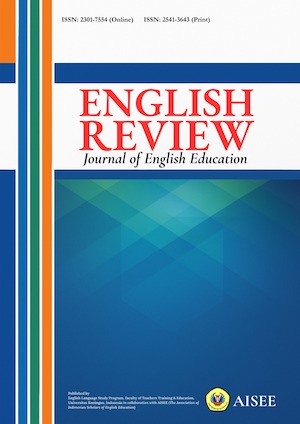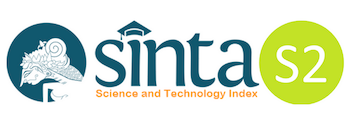CONVERSATIONAL IMPLICATURE IN MABA BELO SELEMBAR DIALOGUE OF KARONESE CULTURE
Abstract
Abstract: Implicit meaning or supplementary meaning of the speaker's speech is revealed by implicature analysis, a technique employed in pragmatics. This research is expected to provide a deeper understanding of implicatures in the Karonese language and can assist in preserving the Karonese language and culture. The research method used in this research is the descriptive-analytical method. The data used in this study were obtained from video recordings of Maba Belo Selambar conversations taken from youtube. Descriptive qualitative analysis was used to analyze the social phenomena in depth and comprehensively, explaining or describing these phenomena in detail. The data analysis would be based on the implications developed by Grice in exploring cooperative communication in conversation and using Jakobson's theory of language function to see the implications of the conversation. The writer found 35 pieces of data that consist of implicacies based on the function of language. After analyzing the data, the researcher finds that the metalinguistic function (15 data) is the most dominant, followed by the comparative function (11 data), the referential function (6 data points), the phonic function (2 data) and the poetic function (1 data). The author found that the use of language functions in metalinguistics was more likely to be used because the speakers on both sides threw structured, ethical language codes at the event.
References
Afrilesa Jasmir, R. (2021). an Analysys of Conversational Implicature in Podcast Deddy Corbuzier’S Youtube. TELL-US Journal, 7(1), 80–94. https://doi.org/10.22202/tus.2021.v7i1.4824
Babali, A. G. (2023). The ways of representing hidden meanings in English-language fiction discourse. Revista Amazonia Investiga, 12(69), 304–314. https://doi.org/10.34069/ai/2023.69.09.27
Beru Ginting, S. U. (2017). Semiotik Makna Pada Wacana Ngembah Belo Selambar Adat Karo Langkat (Kajian Semiotika Sosial). Jurnal Pena Indonesia, 3(2), 130. https://doi.org/10.26740/jpi.v3n2.p130-146
Borchmann, S. (2024). Headlines as illocutionary subacts: The genre-specificity of headlines. Journal of Pragmatics, 220, 73–99. https://doi.org/10.1016/j.pragma.2023.12.007
Colonna Dahlman, R. (2022). Conveying meaning in legal language – Why the language of legislation needs to be more explicit than ordinary language. Journal of Pragmatics, 198, 43–53. https://doi.org/10.1016/j.pragma.2022.05.009
Dey, M. (2023). The primary characteristics of English pragmatics in Applied Linguistics. Journal of English Teaching, Applied Linguistics and Literatures (JETALL), 6(2), 125. https://doi.org/10.20527/jetall.v6i2.16056
Febrianti, R., Usman, F., & Sawirman, S. (2022). Directive Speech Acts Used by Teacher Via Zoom Cloud Meeting in English School Indonesia. Randwick International of Education and Linguistics Science Journal, 3(4), 675–678. https://doi.org/10.47175/rielsj.v3i4.611
Goodman, N. D., & Frank, M. C. (2016). Pragmatic Language Interpretation as Probabilistic Inference. Trends in Cognitive Sciences, 20(11), 818–829. https://doi.org/10.1016/j.tics.2016.08.005
Grice, H. . (1975). Login and Conversation. In Syntax and Semantics. Edited by Cole and J.Morgan (Vol. 9, pp. 41–58).
Hall, A., & Mazzarella, D. (2023). Pragmatic inference, levels of meaning and speaker accountability. Journal of Pragmatics, 205, 92–110. https://doi.org/10.1016/j.pragma.2022.12.007
Hang, X. (2023). Email Etiquette: A Pragmatic Analysis. Frontiers in Humanities and Social Sciences, 3(8), 77–79. https://doi.org/10.54691/fhss.v3i8.5540
Hidayati, F., & Mahmud, M. (2022). Conversational implicature in the green book movie. Journal of English Literature and Cultural Studies (JELCS Journal), 1(1), 50–62. https://www.researchgate.net/publication/334970976
Holtgraves, T. M., & Kashima, Y. (2008). Language, meaning, and social cognition. Personality and Social Psychology Review, 12(1), 73–94. https://doi.org/10.1177/1088868307309605
Jiun, P. W. Y. (2020). Indigenous, local and regional traditions: Views from ritual and ceremony. International Journal of Asia-Pacific Studies, 16(2), 1–9. https://doi.org/10.21315/ijaps2020.16.2.1
Jr Mahinay Mabaquiao, N., Mabaquiao, N. M., & De, J. (2018). Speech Act Theory: From Austin to Searle. Augustinian: A Journal for Humanities, Social Sciences, Business, and Education, December 2018, 19. https://www.researchgate.net/publication/353274370
Kanaza, Fauzia, U. (2020). Jurnal etnolingual. Jurnal Etnolingual, 4(1), 54–73. https://doi.org/10.20473/etno.v4i2.20347
Kausar, A. R., Kasmantoni, K., & Bustomi, B. (2022). Implication of Conversation in Interactive Dialogue of Public Eyes in Trans 7. Jadila: Journal of Development and Innovation in Language and Literature Education, 2(3), 261–270. https://doi.org/10.52690/jadila.v2i3.212
Klemenčič, E., & Čepič Vogrinčič, M. (2014). Analysis of texts in the field of education: A regulation on textbook approval and a history textbook. SAGE Open, 4(3), 1–9. https://doi.org/10.1177/2158244014552430
Kurniawati, putri. (2017). No Titleالابتزاز الإلكتروني.. جرائم تتغذى على طفرة «التواصل ال. In Universitas Nusantara PGRI Kediri (Vol. 01).
Maraini, D. (2015). Board of regents of the university of Oklahoma. World Literature Today, 89(3–4), 56. https://doi.org/10.7588/worllitetoda.89.3-4.0056
Mazzarella, D., & Vaccargiu, E. (2024). Communication: Inferring speaker intentions or perceiving the world? Insights from developmental research. Journal of Pragmatics, 221, 123–136. https://doi.org/10.1016/j.pragma.2023.12.014
Moeschler, J. (2012). Conversational and conventional implicatures. Cognitive Pragmatics, January 2012, 405–433. https://doi.org/10.1515/9783110214215.405
Nelson, P. (2021). Critical Discourse Analysis on Students’ Comments on Tate Confessions. International Journal on Studies in English Language and Literature, 9(9), 9–31. https://doi.org/10.20431/2347-3134.0909002
Papafragou, A. (2018). Pragmatic Development. In Language Learning and Development (Vol. 14, Issue 3, pp. 167–169). Routledge. https://doi.org/10.1080/15475441.2018.1455791
Peltier, J. P. G. (2024). Metalinguistic knowledge of pragmatic markers in Kwéyòl Donmnik and English. Journal of Pragmatics, 226, 103–122. https://doi.org/10.1016/j.pragma.2024.03.013
Pertiwi, W. E., Dadang Sudana, & Andika Dutha Bachari. (2023). Conversational implicature forms of Banyumasan humorous utterances on YouTube. Journal of Research on English and Language Learning (J-REaLL), 4(1), 11–17. https://doi.org/10.33474/j-reall.v4i1.19314
Rhamadani, S. N. F. (2022). The study of conversational implicature in. Jurnal Bahasa, Sastra, Seni, Dan Budaya, 6(2), 333–347.
Rijali, A. (2018). Analisis Data Kualitatif Ahmad Rijali UIN Antasari Banjarmasin. 17(33), 81–95.
Sanakuiev, M. (2022). The Value of Knowledge in the Age of Globalization Challenges: Philosophical and Intellectual Context. Futurity Philosophy, 1, 42–54. https://doi.org/10.57125/fp.2022.06.30.04
Sapitri, P. A., Chasanah, A., Putri, A. A., & Paulima, J. (2020). Exploring Brown and Levinson’s Politeness Strategies: An Explanation on the Nature of the Politeness Phenomenon. REiLA : Journal of Research and Innovation in Language, 1(3), 111–117. https://doi.org/10.31849/reila.v1i3.3801
Sembiring, R. A., Pasaribu, T. K., Tarigan, C. O. S., & Ketaren, S. (2022). Maxims in Karonese song lyrics. Ethical Lingua , Journal of Language Teaching and Literature, 9(2), 787–792. https://doi.org/10.30605/25409190.438
Strawson, P. F. (2011). Review of Paul Grice, Studies in the Way of Words. In Philosophical Writings (pp. 178–185). https://doi.org/10.1093/acprof:oso/9780199587292.003.0015
Swinburne, N. (2024). Expressive meanings and social applications of ‘do’-support questions in Camuno. Journal of Pragmatics, 229, 104–117. https://doi.org/10.1016/j.pragma.2024.06.006
Tagg, C., & Lyons, A. (2024). Conversational rhythm as a disconnective practice among middle-aged adults in situated mobile-messaging interactions. Journal of Pragmatics, 229, 56–70. https://doi.org/10.1016/j.pragma.2024.05.006
Trinh, T. (2024). Forms of address, performative prefixes, and the syntax-pragmatics interface. Journal of Pragmatics, 228, 17–30. https://doi.org/10.1016/j.pragma.2024.05.001
Villalba, X. (2024). Romance exclamative markers at the syntax-pragmatics interface: A compositional approach to exclamativity. Journal of Pragmatics, 226, 64–77. https://doi.org/10.1016/j.pragma.2024.04.004
Xu, Y. (2019). Implicatures. Southern African Linguistics and Applied Language Studies, 37(4), 385–386. https://doi.org/10.2989/16073614.2019.1692683
All articles published in English Review: Journal of English Education (ERJEE) are licensed under the Creative Commons Attribution 4.0 International License (CC BY 4.0).
Copyright Ownership
Authors retain the copyright of their articles and grant ERJEE the right of first publication. The journal is granted a non-exclusive license to publish, reproduce, and distribute the article in any format, medium, or platform, provided that proper credit is given to the original authors.
License Terms – CC BY 4.0
Under the Creative Commons Attribution 4.0 International License, others are free to:
- Share — copy and redistribute the material in any medium or format
- Adapt — remix, transform, and build upon the material for any purpose, even commercially
As long as they:
- Provide appropriate credit to the original author(s) and source
- Provide a link to the license (https://creativecommons.org/licenses/by/4.0/)
- Indicate if any changes were made
There are no restrictions on the reuse, reproduction, or adaptation of published articles as long as attribution is properly given.
Author Warranties
By submitting a manuscript to ERJEE, authors confirm that:
- The work is original and does not infringe any existing copyright.
- The manuscript has not been previously published and is not under consideration elsewhere.
- All sources and references are appropriately acknowledged.
- Necessary permissions have been obtained for any copyrighted materials used.









